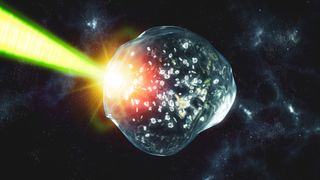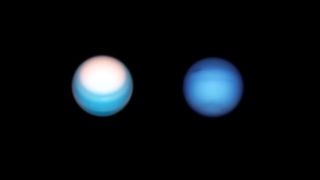Diamond rains could fall through the interior of ice giant planets
Deep with frozen planets like Neptune and Uranus exotic diamond rains could occur more often than previously believed.

An exotic form of precipitation called 'diamond rain' — long thought to occur deep within ice giant planets — could be more common than previously thought.
A team of researchers has experimented with material similar to that found within ice giants such as the solar system planets Neptune and Uranus, discovering that the presence of oxygen increases the possibility of diamond formation and that diamonds could form in low temperatures and pressures.
This means that diamonds could grow in a wide range of conditions throughout these frigid worlds. As a result, this would make the chance of diamond showers raining through the interiors of ice giants more likely.
Related: Yes, there is really 'diamond rain' on Uranus and Neptune
The same experiments also discovered the formation of an exotic form of water that could help explain the magnetic fields of Uranus and Neptune which have thus far confused astronomers.
The research could change our picture of ice giants, theorized by some scientists to be one of the most common forms of exoplanets — planets outside the solar system.
The team of scientists, including researchers from the U.S. Department of Energy's SLAC National Accelerator Laboratory as well as from the Helmholtz-Zentrum Dresden-Rossendorf (HZDR) and the University of Rostock, built on previous research into the conditions and materials within ice giants that observed diamond rains as they formed.
Get the Space.com Newsletter
Breaking space news, the latest updates on rocket launches, skywatching events and more!
The new research predicts that diamonds on Neptune and Uranus could grow to large sizes, potentially up to millions of carats in weight.
Ice giants lack a solid surface but get denser heading towards the core, meaning that over thousands of years the diamonds could sink through ice layers. They would begin to accumulate around the solid heart of the planets forming a thick diamond layer.

Additionally, the team found that a novel phase of water called superionic water and sometimes referred to as 'hot black ice' formed alongside the diamonds.
Superionic water exists at high temperatures and pressures in which water molecules break up with oxygen constituents forming a crystal lattice throughout which hydrogen nuclei float freely.
The hydrogen nuclei are positively charged meaning that superionic water can conduct electric current which could give rise to magnetic fields. This could explain the unusual magnetic fields seen around Uranus and Neptune.
"Our experiment demonstrates how these elements can change the conditions in which diamonds are forming on ice giants," SLAC scientist and team member, Silvia Pandolfi, said in a statement. "If we want to accurately model planets, then we need to get as close as we can to the actual composition of the planetary interior."
A more complicated picture of diamond formation
Siegfried Glenzer, director of the High Energy Density Division at SLAC, explained that the situation inside planets like ice giants is complicated because there are many chemicals to factor into the formation of diamonds.
"The earlier paper was the first time that we directly saw diamond formation from any mixtures," Glenzer said "Since then, there have been quite a lot of experiments with different pure materials. What we wanted to figure out here was what sort of effect these additional chemicals have."
Though the team started their experiments using a plastic material composed of a mix of hydrogen and carbon, elements commonly found in ice giants, the most recent iteration saw this replaced with PET plastic.
Familiar to us on Earth from its uses in packaging, bottles, and containers, PET can be used to more accurately replicate the conditions found within ice giants.
"PET has a good balance between carbon, hydrogen, and oxygen to simulate the activity in ice planets," HZDR physicist and the University of Rostock professor Dominik Kraus said.
Creating shockwaves in the PET with a high-powered optical laser — part of the Matter in Extreme Conditions (MEC) instrument at SLAC — the team was able to probe what was happening in the plastic using X-ray pulses from Linac Coherent Light Source (LCLS).
This allowed them to witness atoms within the PET arrange themselves into diamond-shaped regions, measuring the speed at which these regions grew.
In addition to discovering the diamond-shaped regions grew to scales of around a few nanometers in width, the scientists also found that the presence of oxygen in the PET meant the nanodiamonds grew at lower pressures and lower temperatures than had previously been seen.
"The effect of the oxygen was to accelerate the splitting of the carbon and hydrogen and thus encourage the formation of nanodiamonds," Kraus said. "It meant the carbon atoms could combine more easily and form diamonds."
Nanodiamonds: good things come in small packages
The research could potentially point the way to a new method of fabricating diamonds with a size below 1 micrometer known as 'nanodiamonds' which could be produced when cheap PET plastic is hit with laser-driven shock compression.
"The way nanodiamonds are currently made is by taking a bunch of carbon or diamond and blowing it up with explosives," SLAC scientist and team collaborator, Benjamin Ofori-Okai, said." This creates nanodiamonds of various sizes and shapes and is hard to control. What we're seeing in this experiment is a different reactivity of the same species under high temperature and pressure."
Ofori-Okai added laser production could offer a cleaner and more easily controlled method to produce nanodiamonds. "If we can design ways to change some things about the reactivity, we can change how quickly they form and therefore how big they get," he continued.
Nanodiamonds have a wealth of potential applications in medicine, including in drug delivery, noninvasive surgery, and medical sensors, as well as in the growing field of quantum technology. This means the scientists' findings could have major implications could closer to home than the ice giants that lurk at the solar system's outskirts.
The scientists involved in this research will now attempt experiments using liquid samples containing chemicals such as ethanol, water, and ammonia, some of the main constituents of ice giants to get a better picture of what is occurring beneath the frozen atmospheres of these frigid worlds.
"The fact that we can recreate these extreme conditions to see how these processes play out on very fast, very small scales is exciting," SLAC scientist and collaborator Nicholas Hartley, said. "Adding oxygen brings us closer than ever to seeing the full picture of these planetary processes, but there's still more work to be done.
"It's a step on the road towards getting the most realistic mixture and seeing how these materials truly behave on other planets."
The team's research is published in the latest edition of the journal Science Advances.
Follow us on Twitter @Spacedotcom or on Facebook.
Join our Space Forums to keep talking space on the latest missions, night sky and more! And if you have a news tip, correction or comment, let us know at: community@space.com.

Robert Lea is a science journalist in the U.K. whose articles have been published in Physics World, New Scientist, Astronomy Magazine, All About Space, Newsweek and ZME Science. He also writes about science communication for Elsevier and the European Journal of Physics. Rob holds a bachelor of science degree in physics and astronomy from the U.K.’s Open University. Follow him on Twitter @sciencef1rst.
